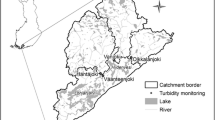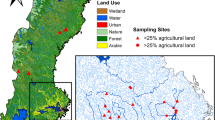Abstract
Purpose
Sediment oxygen demand (SOD) measurement currently requires a long preparation time and bulky experimental equipment, which represent major obstacles to conducting SOD measurements. We developed a new SOD measurement method that can be easily conducted in a shorter time than the existing laboratory method.
Materials and methods
The undisturbed sediment core was transferred into the custom-made small glass vial (inner diameter 12.8 mm, length 125 mm). The SOD sample was incubated in the dark with or without stirring the overlying water inside the vial. The change in DO concentration was measured using a non-contact fluorescent oxygen sensor, and then the SOD was calculated. For comparison and verification of the new method, SOD was also measured using a large undisturbed sediment core (inner diameter 11 cm, length 50 cm).
Results and discussion
The SOD measurements using the new method were positively correlated with the SOD measurements using the large undisturbed sediment core, suggesting that the new method is a feasible alternative to the conventional method. In the new method, many SOD measurements can be taken from a single sediment core sample. This makes it possible to reduce the uncertainty associated with the highly heterogeneous structure of the sediments, and thus the new method has great advantages in obtaining reliable SOD data.
Conclusions
A novel high-throughput method for SOD was developed that shortens sample preparation time and improves convenience of measurement. The new method is expected to contribute substantially to the accumulation of SOD monitoring data and to make great progress in elucidating the dynamics of dissolved oxygen in lakes.







Similar content being viewed by others
References
Baranov V, Lewandowski J, Krause S (2016) Bioturbation enhances the aerobic respiration of lake sediments in warming lakes. Biol Lett 12:20160448
Bowman GT, Delfino JJ (1980) Sediment oxygen demand techniques: a review and comparison of laboratory and in situ systems. Water Res 14:491–499
Boynton WR, Kemp WM, Osborne CG, Kaumeyer KR, Jenkins MC (1981) Influence of water circulation rate on in situ measurements of benthic community respiration. Mar Biol 65:185–190
Edberg N, Hofsten BV (1973) Oxygen uptake of bottom sediments studied in situ and in the laboratory. Water Res 7:1285–1294
Edwards RW, Rolley HLJ (1965) Oxygen consumption of river muds. J Ecol 53:1–19
Gundersen JK, Jørgensen BB (1990) Microstructure of diffusive boundary layers and the oxygen uptake of the sea floor. Nature 345:604–607
Higashino M, Stefan HG (2005) Sedimentary microbial oxygen demand for laminar flow over a sediment bed of finite length. Water Res 39:3153–3166
Hondzo M, Steinberger N (2008) Sediment oxygen demand (SOD) in rivers, lakes, and estuaries. In: Garcia M (ed) Sedimentation Engineering. American Society of Civil Engineer, Virginia, pp 983–993
Inouchi Y (1987) Acoustic estimation method of sedimentation rate –case study in Lake Biwa. Earth Sci 41:231–241 (in Japanese)
Inoue T, Nakamura Y (2009) Effects of hydrodynamic conditions on sediment oxygen demand: experimental study based on three methods. J Environ Eng 135:1161–1170
Irie M, Kubota Y, Nakatsuji K, Nishida S (2007) Estimation of dissolved oxygen consumption in sand beach inhomogeneously contaminated. Proc Coastal Eng 54:1026–1030
Joye SB, Connell TL, Miller LG, Oremland RS, Jellison RS (1999) Oxidation of ammonia and methane in an alkaline, saline lake. Limnol Oceanogr 44:178–188
Kawanabe H, Nishino M, Maehata M (2012) Lake Biwa: interactions between nature and people. Springer, New York
Kazancı N, Leroy SAG, Öncel S, İleri Ö, Toprak Ö, Costa P, Sayılı S, Turgut C, Kibar M (2010) Wind control on the accumulation of heavy metals in sediment of Lake Ulubat, Anatolia, Turkey. J Paleolimnol 43:89–110
Lake Biwa Environmental Research Institute (2015) Research report of sediment survey in Lake Biwa. https://wwwlberijp/app/webroot/files/03yomu/03-01kankoubutsu/files/biwakokoteityousahoukokusyoh23h25saisyupdf Accessed 8 Jun 2020
Lewandowski J, Laskov C, Hupfer M (2007) The relationship between Chironomus plumosus burrows and the spatial distribution of pore-water phosphate, iron and ammonium in lake sediments. Freshw Biol 52:331–343
Mackenthun AA, Stefan HG (1998) Effect of flow velocity on sediment oxygen demand : experiments. J Environ Eng 124:222–230
Mathias JA, Barica J (1980) Factors controlling oxygen depletion in ice-covered lakes. Can J Fish Aquat Sci 37:185–194
Matlock MD, Kevin Ray Kasprzak KR, Osborn GS (2003) Sediment oxygen demand in the Arroyo Colorado River. J Am Water Resour Assoc 39:267–275
McGinnis DF, Berg P, Brand A, Lorrai C, Edmonds TJ, Wüest A (2008) Measurements of eddy correlation oxygen fluxes in shallow freshwaters: towards routine applications and analysis. Geophys Res Lett 35:L04403
Murase J, Sakai Y, Kametani A, Sugimoto A (2005) Dynamics of methane in mesotrophic Lake Biwa, Japan. Ecol Res 20:377–385
Nakamura Y, Stefan HG (1994) Effect of flow velocity on sediment oxygen demand: theory. J Environ Eng 120:996–1016
Nishino M, Ohtaka A, Narita T (1999) Studies on the aquatic oligochaete fauna in Lake Biwa, Central Japan III. Distribution of respective taxa within the lake. Jpn J Limnol 60:539–558
Nolan PM, Johnson F (1979) A method for measuring sediment oxygen demand using a bench model benthic respirometer, New England Regional Laboratory. U.S. Environmental Protection Agency Region 1, Massachusetts
Otubu JE, Hunter JV, Francisco KL, Uchrin CG (2003) Temperature effects on tubificid worms and their relation to sediment oxygen demand. J Environ Sci Health A-Toxic/Hazard Subst Environ Eng 41:1607–1613
Pamatmat MM (1971) Oxygen consumption by the seabed IV. Shipboard and laboratory experiments. Limnol Oceanogr 16:536–550
Rabalais NN, Turner RE, Wiseman WJ (2002) Gulf of Mexico hypoxia, a.k.a. “the dead zone.” Annu Rev Ecol Syst 33:235–263
Rabouille C, Denis L, Dedieu K, Stora G, Lansard B, Grenz C (2003) Oxygen demand in coastal marine sediments: comparing in situ microelectrodes and laboratory core incubations. J Exp Mar Biol Ecol 285–286:49–69
Ramm K, Scheps V (1997) Phosphorus balance of a polytrophic shallow lake with the consideration of phosphorus release. Hydrobiologia 342–343:43–53
Seiki T, Izawa H, Date E, Sunahara H (1994) Sediment oxygen demand in Hiroshima bay. Water Res 28:385–393
Shimotori K, Imai A, Kohzu A, Komatsu K, Sato T, Tomioka N, Shinohara R, Miura S, Okui S, Kiriyama T, Okamoto T (2017) Development of a new method for measuring of sediment oxygen demand in lakes and its application. J Jpn Soc Water Environ 40:21–29
Sommaruga R (1991) Sediment oxygen demand in man-made Lake Ton-Ton (Uruguay). Hydrobiologia 215:215–221
Søndergaard M, Jensen JP, Jeppesen E (2003) Role of sediment and internal loading of phosphorus in shallow lakes. Hydrobiologia 506–509:135–145
Sweerts JPRA, St Louis V, Cappenberg TE (1989) Oxygen concentration profiles and exchange in sediment cores with circulated overlying water. Freshw Biol 21:401–409
Sweerts JPRA, Baer-Gilissen MJ, Cornelese AA (1991) Oxygen-consuming processes at the profundal and littoral sediment-water interface of a small meso-eutrophic lake (Lake Vechten, The Netherlands). Limnol Oceanogr 36:1124–1133
Tanahashi M, Fukuchi Y, Choi GM, Fukuzato K, Miyauchi T (2004) The time -resolved stereoscopic digital particle image velocimetry up to 26.7 kHz. Proc 12th Int Symp Applli Laser Tech Fluid Mech
Truax D, Shindala A, Sartain H (1995) Comparison of two sediment oxygen demand measurement techniques. J Environ Eng 121:619–624
Utley BC, Vellidis G, Lowrance R, Smith MC (2008) Factors affecting sediment oxygen demand dynamics in blackwater streams of Georgia’s coastal plain. J Am Water Resour Assoc 44:742–753
Veenstra JN, Nolen SL (1991) In-situ sediment oxygen demand in five Southwestern U.S. lakes. Water Res 25:351–354
Wallace TA, Ganf GG, Brookes JD (2016) Sediment oxygen demand in a constructed lake in South-Eastern Australia. J Environ Manag 181:449–454
Wang X, Matisoff G (1997) Solute transport in sediments by a large freshwater oligochaete, Branchiura sowerbyi. Environ Sci Technol 31:1926–1933
Acknowledgments
We would like to express our gratitude to Mr. Takeshi Kikuta and Nobuhiro Oda, Seika Digital Image CORPORATION for performing flow velocity measurement using PIV System. We thank Alex Boon for editing the manuscript.
Funding
This study was supported by the Collaborative Research Fund from Shiga Prefecture entitled “Study on water quality and lake-bottom environment for protection of the soundness of water environment” under the Japanese Grant for Regional Revitalization.
Author information
Authors and Affiliations
Corresponding author
Additional information
Responsible editor: Nives Ogrinc
Publisher’s note
Springer Nature remains neutral with regard to jurisdictional claims in published maps and institutional affiliations.
Supplementary information
Rights and permissions
About this article
Cite this article
Shimotori, K., Yamamoto, H., Imai, A. et al. Development of a new high-throughput and small-size method for measuring sediment oxygen demand in lakes. J Soils Sediments 21, 1222–1231 (2021). https://doi.org/10.1007/s11368-020-02828-4
Received:
Accepted:
Published:
Issue Date:
DOI: https://doi.org/10.1007/s11368-020-02828-4




